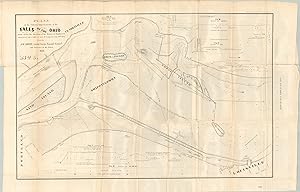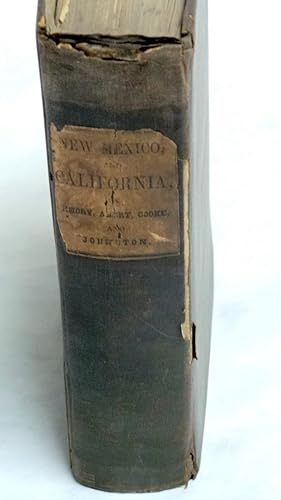Lieut J W Abert (4 results)
Product Type
- All Product Types
- Books (4)
- Magazines & Periodicals
- Comics
- Sheet Music
- Art, Prints & Posters
- Photographs
- Maps
-
Manuscripts &
Paper Collectibles
Condition
- All Conditions
- New
- Used
Binding
- All Bindings
- Hardcover (3)
- Softcover
Collectible Attributes
- First Edition (2)
- Signed
- Dust Jacket
- Seller-Supplied Images (3)
- Not Printed On Demand
Seller Location
Seller Rating
-
Condition: Very Good. "Situated between Louisville, Kentucky and Clarksville, Indiana lies the Falls of the Ohio, a natural rock formation that was one of the few barriers to navigation on the Ohio River in the early 19th century. Both cities grew from trade in the portage business, but it was quickly recognized that an alternative solution was needed to maximize economic growth. The privately owned Louisville and Portland Canal opened for traffic in 1830, but by the early 1850s a significant portion of river traffic was too large to fit through the channel. Federal improvements were constantly necessary to maintain its efficacy, and by 1855 a total buyout by the government was completed. This map of the area around the falls was drawn by Lieutenant J.W. Abert, Engineer for the Topographic Corps of the United States Army. It was likely published by the Government Printing Office a few years later as part of a government report, with lithography performed by Auguste Hoen & Co. in Baltimore. The canal can clearly be seen, along with proposed improvements to its entrance near 9th Street in Louisville. Depth soundings and navigational hazards are noted throughout. Numerous diagrams in the negative space show cross sections of the river with corresponding high and low water levels. Also of interest is the United States Marine Hospital in the lower center. The building was constructed in 1852 and is one of the best-preserved antebellum hospitals in the United States. Interstate 64 runs approximately along the route of the former plank road. Source: U.S. Army Corps of Engineers;" Sheet Width (in) 36.4 Sheet Height (in) 23.6 Condition Description Moderate creasing and wear along originally issued fold lines, including separation at fold intersections and along the outer edges of the sheet, wrinkling, and light toning. Very minimal, if any, image loss. A few small tears are confined to the outer edges of the margins. Good to very good overall.
-
Notes of a Military Reconnoissance from Fort Leavenworth, in Missouri, to San Diego, in California, Including Part of the Arkansas, Del Norte, and Gila Rivers / Report of Lieut. J. W. Abert, of his Examination of New Mexico, in the Years 1846-47 / Report
Published by Wendell and Van Benthuysen, Washington, D.C., 1848
Seller: Saucony Book Shop, Kutztown, PA, U.S.A.
First Edition
Original Cloth. Condition: Good. Dust Jacket Condition: Not Issued. First Edition. House Exec. Doc. No. 41, 30th Congress, 1st Session. Howes E 145 (1st issue). Original brown cloth, lettered in gilt. Lacks both flyleaves and title page, opens directly onto Secretary of War W. L. Marcy's letter dated 9 Feb. 1848 (p. 3), thus 3-614 pp., collated and complete except as noted with (64) lithographic plates including (26) in Emory's report, (14) botanical illustrations accompanying Engelmann's report, and (24) in Abert's report, plus (3) battle plan maps also in Emory between pp. 108-120. House edition (i.e. first issue), far more scarce than the (second issue) Senate edition (which was only 416 pp.), with possibly the first known rendering of Santa Fe on the plate opposite p. 419. Lacking the (2) folding maps and the large folding map which may not yet have been available upon issue (see Howes E 145 note). Considerable wear, but mostly intact. Cloth is somewhat soiled and spotted, with exposure at corners, chipped at tail of spine with some separation along joints and approx. 1" of minor loss along lower front joint, small vintage paper label mounted on upper spine (though not otherwise marked as an institutional copy). Signed on front pastedown and along top edge of p. 3 by former owner H. W. Clapham, a page in the U.S. House of Representatives, Washington, D.C., 1848-49. Front hinge shows some evidence of amateur repair, but the binding is still intact, all leaves and plates present and firmly anchored excepting pp. 71-74 (which, along with 3 adjacent plates, are partially detached but fully intact). Text block edges somewhat dulled by age, interior with light scattered foxing, engraved plates mostly clean also with light foxing. Scarce edition. CONTENTS: 1) Notes of a Military Reconnoissance from Fort Leavenworth, in Missouri, to San Diego, in California, Including Part of the Arkansas, Del Norte, and Gila Rivers / 2) Report of Lieut. J. W. Abert, of his Examination of New Mexico, in the Years 1846-47 / 3) Report of Lieut. Col. P. St. George Cooke of his March from Santa Fe, New Mexico, to San Diego, Upper California / 4) Journal of Captain A. R. Johnston, First Dragoons. Size: 8vo - over 7¾" - 9¾" tall. Book.
-
Notes of a Military Reconnaissance, from Fort Leavenworth, in Missouri, to San Diego, in California, Including Parts of the Arkansas, Del Norte, and Gila Rivers 13th Congress, 1st Session. Ex. Doc. No. 41. [Includes Reports of Lieut. J. W. Abert, Lieut. Col. P. St. George Cooke, Journal of Capt. A. R. Johnson. ]
Published by Wendell and Van Benthuysen, Printers, Washington, D. C., 1848
Seller: G.F. Wilkinson Books, member IOBA, GRASS VALLEY, CA, U.S.A.
Association Member: IOBA
Hardcover. Condition: Poor. Joint split with spine laid down, chipped at edges; rubbing to edges and bumped corners; front endpaper torn; owner signature second endpaper, two bookplates, one for Frederick Wm. Zimmerman, one for Alfred I. Exberg. Hinge starting lower 2 inches at title page, but cord binding holding firm. First folding map of New Mexico with tape repairs to back; degrees of foxing in general to text pages and plates from mild to moderate, occasionaly heavy, yet many pages and plates remain relatively clean. ; Original brown cloth, and paper spine label; 4 sketches; 26 plates; 10 of 12 botanical plates called for, also lacking 2 botanical plates called for in appendix. Abert's report with 23 of 24 plates, lacking Pueblo de Santa Ana; 2 folding maps. Conforms to Wagner-Camp 148: 5. ; 8vo 8" - 9" tall; 614 pages.
-
Notes of a Military Reconnoissance, from Fort Leavenworth, in Missouri, to San Diego, in California, Including Part of the Arkansas, Del Norte, and Gila Rivers; AND, Report of Lieut. J. W. Abert; AND, Cook's March from Santa Fe; AND, Journal of Johnston
Published by Wendell and Van Benthuysen., Washington, 1848
Seller: Ziern-Hanon Galleries, Frontenac, MO, U.S.A.
First Edition
Full Cloth. Condition: Good. First Edition. FIRST EDITION. House of Representatives Edition which proceeds the Senate edition. Title page mistakenly lists Emory as "Lieut. Col.". Original dark brown cloth with paper label title "New Mexico, and California, by Emory, Abert, Cooke, and Johnston". Contains some scuffs and nicks. Right spine edge is loose. Pages are age-toned and stiff with a few foxed. Includes wonderful pen and ink drawings in fine condition. Two fold out maps and three maps of battles in California with the Mexicans. Large fold-out map with 5" tear from inner margin affecting the map, "The Territory of New Mexico, 1846-47"; 67 plates. Page 454 misprinted as 754. 614pp. Overall GOOD minus condition. Extreemely scarce first edition. Damp staining to bottom corner throughout. Previous owner's notes on first page from 1929. Includes the reports of J.W. Abert and Philip St. George Cooke. Together they summarize the activity of the U.S. Army to the west of Santa Fe after the capture of New Mexico by the Army of the West. The first folding map is Philip St. George Cooke's "Sketch of Part of the march & Wagon road of Lt. Colonel Cooke, from Santa Fe to the Pacific Ocean, 1846-7." This shows the route of the Mormon Battalion from Santa Fe to the Gila River. The other, "Map of the Territory of New Mexico," was compiled by Lieutenants Abert and Peck after the conquest of New Mexico. Both are important contributions to western cartography. Abert's report includes material on the Indians of New Mexico and their languages. The Abert report also includes all of his views of New Mexico, the best group of early New Mexico views published. Wagner-Camp is in error in its collation of this edition, mistakenly calling for only forty plates, plus those of the Abert report. William Hemsley Emory (September 7, 1811 -- December 1, 1887) was an United States Army officer and surveyor of Texas. Emory was born in Queen Anne's County, Maryland, on his family's "Poplar Grove" estate. He attended the United States Military Academy at West Point, New York, and graduated in 1831. Assigned as a second lieutenant, he served in the Corps of Engineers until he resigned from the service in 1836 to pursue civil engineering, but he returned to the service in 1838.During that same year, he married a great-grandaughter of Benjamin Franklin, Matilda Wilkins Bache of Philadelphia. The couple would have three children. During his second stint in the army, he was successively promoted from lieutenant to captain and finally to major. He specialized in mapping the United States border, including the Texas-Mexico border, the United States-Canadian border(1844 1866) and the Gadsen Purchase (1854 -- 1857). In 1844, Emory served in an expedition that produced a new map of Texan claims westward to the Rio Grande River. He came to public attention as the author of the Notes of a Military Reconnaissance from Fort Leavenworth in Missouri to San Diego, California, published by the Thirtieth United States Congress in 1848. This report described terrain and rivers, cities and forts and made observations about Indians, Mexicans, primarily in New Mexico Territory, Arizona Territory and Southern California. It was and is considered one of the important chronicles and descriptions of the historic Southwest, particularly noted for its maps. Emory was a reliable and conscientous cartographer. Size: 8vo - over 7¾" - 9¾" tall. Hardcover.




![Seller image for Notes of a Military Reconnaissance, from Fort Leavenworth, in Missouri, to San Diego, in California, Including Parts of the Arkansas, Del Norte, and Gila Rivers 13th Congress, 1st Session. Ex. Doc. No. 41. [Includes Reports of Lieut. J. W. Abert, Lieut. Col. P. St. George Cooke, Journal of Capt. A. R. Johnson. ] for sale by G.F. Wilkinson Books, member IOBA](https://pictures.abebooks.com/inventory/md/md31523545697.jpg)
